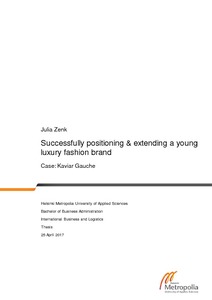Successfully positioning & extending a young luxury fashion brand : Case: Kaviar Gauche
Zenk, Julia (2017)
Zenk, Julia
Metropolia Ammattikorkeakoulu
2017
All rights reserved
Julkaisun pysyvä osoite on
https://urn.fi/URN:NBN:fi:amk-2017052710560
https://urn.fi/URN:NBN:fi:amk-2017052710560
Tiivistelmä
This research revolves around a case study provided by Kaviar Gauche, a young luxury fashion label from Berlin. While initially releasing regular ready-to-wear collections in the first years of existence, the brand is nowadays mainly known for its contemporary bridal couture designs.
The literature review intends to give the reader an understanding of basic marketing theories connected to customer needs, as well as the methods of branding – both in general and in the context of the luxury industry. Additionally, the role of the relationship between firms and consumers in connection to building brand equity and position is examined. It is also illuminated why and how brands can or may have to change through repositioning or extending.
With information based on an interview with Kaviar Gauche’s marketing manager, the results describe the brand’s beginning endeavours on the high fashion market, its transition to a new segment, as well as current brand developments. In connection to these findings, success factors of Kaviar Gauche are analysed with connection to additional sources.
The research finally concludes how branding techniques in literature compare to Kaviar Gauche’s real-life example, as well as the role of branding, positioning and customer needs for newly founded companies. The last chapter exhibits recommendations for start-ups, as well as for Kaviar Gauche’s future.
The literature review intends to give the reader an understanding of basic marketing theories connected to customer needs, as well as the methods of branding – both in general and in the context of the luxury industry. Additionally, the role of the relationship between firms and consumers in connection to building brand equity and position is examined. It is also illuminated why and how brands can or may have to change through repositioning or extending.
With information based on an interview with Kaviar Gauche’s marketing manager, the results describe the brand’s beginning endeavours on the high fashion market, its transition to a new segment, as well as current brand developments. In connection to these findings, success factors of Kaviar Gauche are analysed with connection to additional sources.
The research finally concludes how branding techniques in literature compare to Kaviar Gauche’s real-life example, as well as the role of branding, positioning and customer needs for newly founded companies. The last chapter exhibits recommendations for start-ups, as well as for Kaviar Gauche’s future.
